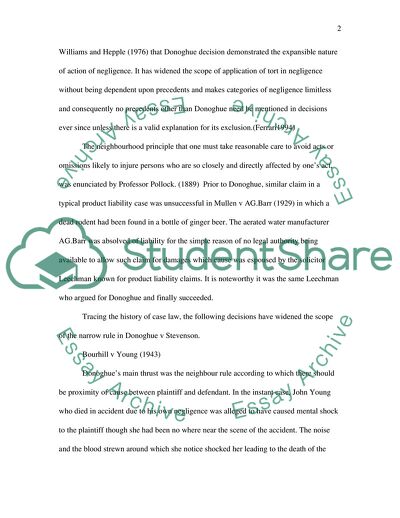
- Home
- Free Samples
- Premium Essays
- Editing Services
- Extra Tools
- Essay Writing Help
- About Us
- Studentshare
- Subjects
- Miscellaneous
- Discuss, in terms of the common law, how the narrow rule in Donoghue v Stevenson, in terms of liability for defective products, has been developed since 1932
Discuss, in terms of the common law, how the narrow rule in Donoghue v Stevenson, in terms of liability for defective products, has been developed since 1932 - Essay Example

- Subject: Miscellaneous
- Type: Essay
- Level: Undergraduate
- Pages: 4 (1000 words)
- Downloads: 0
- Author: kenna44
Extract of sample "Discuss, in terms of the common law, how the narrow rule in Donoghue v Stevenson, in terms of liability for defective products, has been developed since 1932"
(Heuston 1957) This decision not only influenced product liability but also the law of torts. Earlier to this decision, manufacturer had no liability to the victim or the consumer if he had not purchased directly from him. Even otherwise, the liability was under contract and not under delict or tort. Donoghue decision that rejected the fallacy of no duty of care to the consumer either under contract or tort was perhaps motivated by the decisions in America in MacPherson v Buick Motor Co (1916) and in Canada in Buckley v Mott. (1920) wherein delictual liability of the manufacturer to the consumer had been recognised.
Ferrari (1994) says that Donoghue decision is far more important to the law of torts than to its contribution to the concept of product liability. He predicts that the celebrated Snails case will have its influence forever as it revolutionised the law of negligence as noted by Williams and Hepple (1976) that Donoghue decision demonstrated the expansible nature of action of negligence. It has widened the scope of application of tort in negligence without being dependent upon precedents and makes categories of negligence limitless and consequently no precedents other than Donoghue need be mentioned in decisions ever since unless there is a valid explanation for its exclusion.
(Ferrari1994) The neighbourhood principle that one must take reasonable care to avoid acts or omissions likely to injure persons who are so closely and directly affected by one’s act, was enunciated by Professor Pollock. (1889) Prior to Donoghue, similar claim in a typical product liability case was unsuccessful in Mullen v AG.Barr (1929) in which a dead rodent had been found in a bottle of ginger beer. The aerated water manufacturer AG.Barr was absolved of liability for the simple reason of no legal authority being available to allow such claim for damages which cause was espoused by
...Download file to see next pages Read MoreCHECK THESE SAMPLES OF Discuss, in terms of the common law, how the narrow rule in Donoghue v Stevenson, in terms of liability for defective products, has been developed since 1932
Business Law: Donoghue v. Stevenson
Donoghue v Stevenson Analysis
Liability for Supply of Defective Product
Donoghue v Stevenson Case Analysis
Business Law in Australia (Tort)
Development of Duty of Negligence since Donoghue v Stevenson
Donoghue v Stevenson
Tort Law - MAlister v Stevenson

- TERMS & CONDITIONS
- PRIVACY POLICY
- COOKIES POLICY